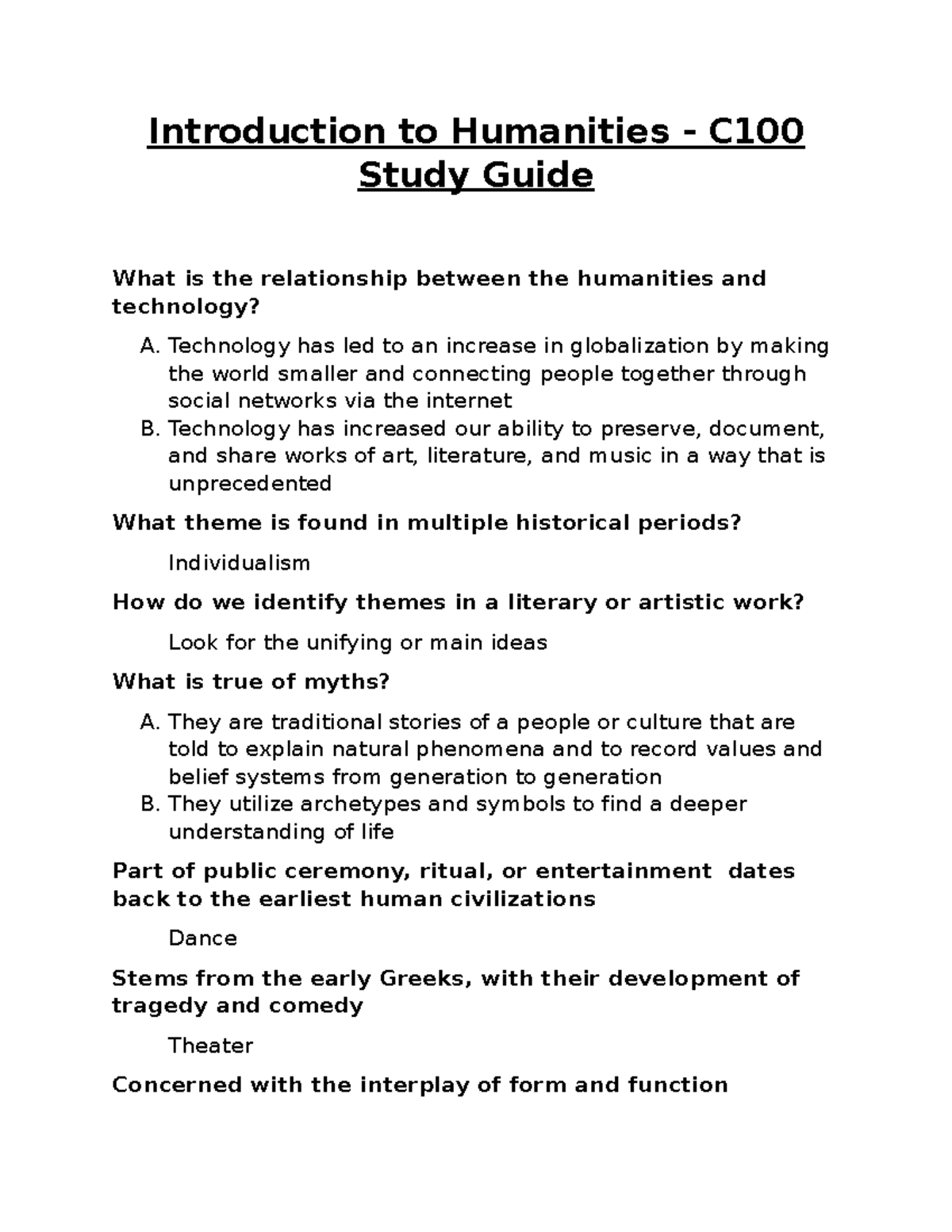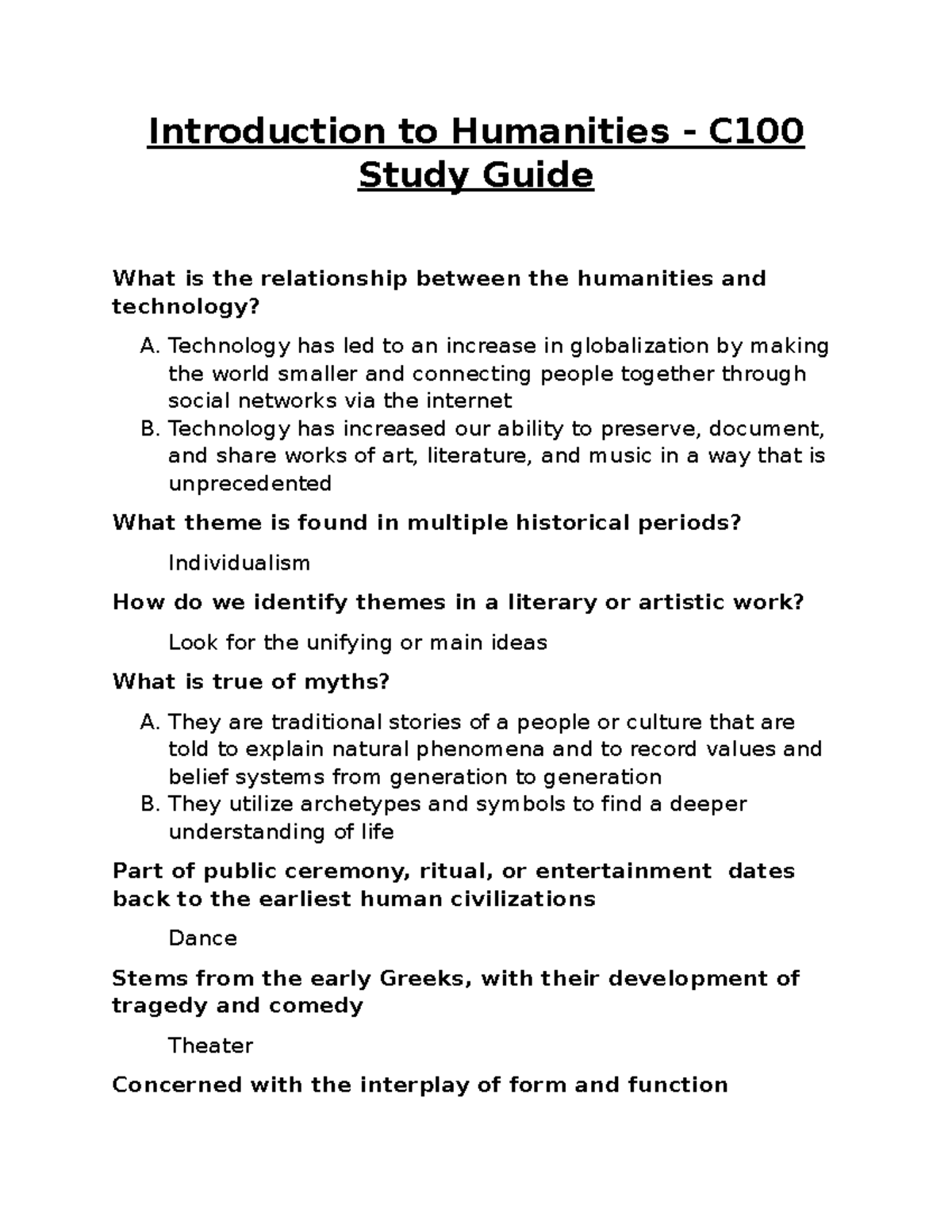Introductory humanities courses are designed to ignite the curiosity of first-year students and draw them into the rich tapestry of arts and culture. With an emphasis on engaging humanities courses, these programs aim to combat the declining interest in humanities education initiatives seen nationwide. Led by initiatives from dedicated educators, the first-year arts curriculum is evolving with innovative offerings that challenge traditional paradigms. Professors are not only rethinking content but are also striving to create a transformative experience for students, fostering a deeper appreciation for creative writing and humanities. As students embark on this educational journey, these courses promise to explore fundamental questions about human existence and culture, encouraging young minds to define their paths in the arts.
The realm of foundational coursework in the arts encompasses a variety of disciplines aimed at immersing students in diverse cultural narratives. These introductory programs serve as a vital step for undergraduates, particularly those entering the arts landscape, to uncover the significance of human expression through various media. By redefining the first-year arts experience, educators hope to enhance engagement and curiosity in humanities studies, a crucial element for cultivating future scholars. The innovations within this curriculum not only entice students to explore the depth of humanities but also equip them with essential skills in creative analysis and writing. Embracing this approach can revolutionize how students perceive and engage with the complexities of human culture.
Engaging First-Year Students: A New Approach to Humanities Education
The introduction of nine new courses specifically designed for first-year students reflects a significant shift in how humanities education is approached. This initiative spearheaded by Dean Sean Kelly aims to captivate and engage first-year students in arts courses that resonate with their interests and experiences. By addressing the nationwide decline in humanities enrollments, these courses strive to deepen students’ understanding of the intrinsic value of the humanities, bridging gaps in traditional high school curricula that often overlook these subjects. Given that nearly half of first-year students change their concentration by their sophomore year, the emphasis on creating engaging, relevant introductory courses is crucial for fostering lasting interest in the arts and humanities.
Students today are not just looking for information; they crave connection and relevance in their studies. This realization has prompted faculty members to rethink the content and delivery of humanities courses, moving away from standard lectures towards more interactive, discussion-based formats. For instance, courses that explore contemporary issues within the framework of classic humanistic inquiry not only ignite curiosity but also encourage students to think critically about the world around them. By aligning the curriculum with students’ experiences and interests, professors aim to create an environment that is not only educational but also transformative, ensuring that first-year students feel empowered to engage deeply with the material.
Creative Writing and Humanities: Merging Disciplines for Comprehensive Learning
In an innovative twist, the new introductory courses blend creative writing with traditional humanities studies, illustrating how interconnected these fields can be. The course ‘Reading for Fiction Writers’ emphasizes the importance of analysis in creative expression, demonstrating that great writing is rooted in the understanding of literature. This approach recognizes that successful writers are often voracious readers who can discern nuances in text, leading to richer storytelling. By integrating creative writing into the first-year arts curriculum, students not only learn to appreciate literature but also to reflect on their own writing styles, thereby fostering a comprehensive understanding of the humanities as a whole.
Moreover, creative writing initiatives within the humanities serve to attract students who may not have considered themselves traditionally ‘artsy’ but possess a passion for storytelling. By highlighting the creative aspects of humanities courses, institutions can engage a broader array of first-year students. The inclusion of contemporary authors and diverse perspectives not only enriches the learning experience but also makes the study of humanities more accessible and relatable. This approach is in line with the overarching humanities education initiatives aimed at revitalizing student interest while ensuring that graduates possess valuable skills in critical thinking, creativity, and cultural awareness.
Rethinking the First-Year Arts Curriculum
The first-year arts curriculum is undergoing a significant transformation, with new courses that reflect the complexities of modern society and its diverse narratives. Recognizing that traditional curriculums often failed to resonate with students, faculty now emphasize contemporary themes and issues such as migration, technology, and health. This shift not only helps students relate to the material but also prepares them for nuanced discussions that they will likely encounter in their personal and professional lives. Courses like ‘Migration and Border Crossing in Film and Photography’ serve as prime examples of how innovative topics can engage students meaningfully from the start of their academic journey.
Additionally, this reformation of the first-year arts curriculum incorporates various teaching methodologies designed to foster active participation. Rather than passively absorbing information, students are encouraged to engage both critically and creatively with the material. This includes collaborative projects, multimedia presentations, and external perspectives that advocate for an interactive and engaging educational experience. By focusing on how the arts and humanities relate to real-world experiences, these newly designed courses aim to pique curiosity about the broader implications of culture and society, laying a strong foundation for future explorations in the humanities.
Broadening Access to Humanities through Innovative Course Offerings
One of the key goals of the new introductory courses in the humanities is to broaden access and appeal to a diverse group of students. By introducing subjects like ‘Humanity, Technology, and Creation,’ the curriculum seeks to engage students with varied interests and backgrounds. This inclusivity is essential for fostering a robust educational environment where diverse perspectives can thrive. It challenges the traditional notion of what constitutes a humanities education and encourages students to explore intersections between technology and human experiences, prompting critical discussions about the impact of modern advancements on our society.
Moreover, by offering unique courses that are not always found in standard academic programs, universities can attract prospective students who may otherwise overlook the humanities altogether. These innovative offerings not only establish a connection with students but also affirm the relevance of the humanities in today’s rapidly changing world. By emphasizing contemporary themes and appealing to students’ interests, universities can create an enduring cultural impact while ensuring that the disciplines remain vital and engaging throughout their academic careers.
Inspiring a New Generation of Humanities Scholars
The launch of nine new humanities courses is not just about attracting first-year students—it is also about inspiring them to become lifelong scholars in the field. By providing a foundation in both classical and contemporary humanities topics, these courses aim to cultivate a passion for the arts while equipping students with analytical skills necessary for academic inquiry. The fusion of creative writing with critical analysis highlights the versatility of the humanities and encourages students to find their unique voice within this broad discipline. As students delve into discussions about moral philosophy or cultural criticism, they are supported in their exploration of what it means to be human, transforming them into thoughtful citizens.
To maximize the efficacy of these new learning opportunities, the faculty is committed to creating an inclusive atmosphere that encourages dialogue and intellectual curiosity. By promoting a sense of community among first-year students, these courses can significantly enhance peer interactions and collaborative learning. This not only contributes to personal growth but also underscores the importance of humanities education initiatives in fostering connections among students. In doing so, they empower the next generation to engage with the world critically and empathetically, shaping a cohort of scholars who are not only knowledgeable but also socially aware and responsible.
The Role of Faculty in Shaping Humanities Identity
Faculty members play a pivotal role in shaping the identity of humanities education through their innovative course designs and teaching methodologies. By incorporating their expertise and personal passions into the curriculum, professors inspire students to connect with the material on a deeper level. This personal investment in course content can lead to increased student engagement, as learners find themselves captivated by the subject matter presented through the lens of passionate educators. As seen in courses like ‘Bob Dylan the Classic,’ the exploration of familiar cultural figures can serve as stepping stones to broader discussions about literature and art, reinforcing the notion that the humanities are not just academic subjects, but avenues for personal exploration.
Furthermore, the commitment of faculty to rethink traditional approaches demonstrates a strong dedication to adapting education to the evolving interests of students. In doing so, they not only address enrollment declines but also work to reinvigorate the humanities landscape by making it vibrant and accessible. Faculty-driven initiatives and their participation in curriculum development are crucial to retaining first-year students’ interests in humanities courses and to instilling a sense of pride and identity within these fields. Their leadership paves the way for an enriching educational experience that honors both historical texts and contemporary issues, fostering a well-rounded and inclusive understanding of what it means to study the humanities.
Transformative Learning through Inter-Disciplinary Connections
The introduction of new courses reflects a growing recognition within humanities education that interdisciplinary connections can greatly enhance learning. By blending concepts from different fields such as literature, philosophy, and social sciences, courses offer students a more comprehensive understanding of complex issues. For instance, exploring the connections between ‘Migration and Border Crossing in Film and Photography’ provides a multifaceted look at cultural narratives, encouraging students to draw links between artistic expression and pressing societal challenges. This interdisciplinary approach not only broadens students’ perspectives but also prepares them for tackling real-world issues.
Moreover, fostering inter-disciplinary dialogue within the humanities encourages collaboration between departments, enriching the academic environment. The merging of knowledge across various arts courses aims to spur creativity and innovation, allowing students to apply diverse methodologies to their studies. As students embark on this holistic educational journey, they are equipped with varied tools to analyze texts, cultural artifacts, and historical contexts. This prepares them not only for future academic pursuits but for careers where the ability to synthesize information from multiple disciplines is increasingly valuable.
Building a Bridge Between High School and College Humanities
One of the pressing challenges facing higher education is the bridge between high school and college humanities courses that often feels like a chasm to incoming first-year students. Many high school curricula do not adequately prepare students for the rigors and expectations of college-level humanities studies. Recognizing this gap, higher education institutions are implementing strategies to create smoother transitions for students entering the arts and humanities. These newly developed introductory courses aim to not only captivate students’ interest but also provide them with foundational skills that will make their adjustment to college life more manageable.
In addition to rethinking course content, it is crucial that educators collaborate with high school teachers to align expectations and curricula. By fostering partnerships between secondary and post-secondary education systems, universities can provide resources and support to help high school teachers emphasize the importance of the humanities. This synergy will ultimately help cultivate a culture of appreciation for arts courses and critical thinking skills, ensuring that students arrive on campus excited and prepared to engage deeply in humanities studies.
Frequently Asked Questions
What are the benefits of introductory humanities courses for first-year students?
Introductory humanities courses offer first-year students a crucial foundation in understanding cultural, philosophical, and artistic concepts. These engaging courses help students explore fundamental questions about humanity and cultivate critical thinking skills relevant to any career path.
How do new engaging humanities courses address declining enrollment in arts programs?
The newly launched engaging humanities courses respond to declining enrollment by captivating first-year students with diverse topics and interactive teaching methods. This initiative also aims to highlight the intrinsic value of humanities education and encourage more students to pursue arts disciplines.
What types of topics are covered in first-year arts courses?
First-year arts courses cover a range of topics, including cultural context, migration in film, medical and health humanities, and even relationships through philosophy. These subjects aim to resonate with students’ interests and foster an appreciation for humanities education.
How can creative writing and humanities courses support first-year students?
Creative writing and humanities courses support first-year students by developing their ability to analyze texts while simultaneously enhancing their storytelling skills. This dual approach not only improves their writing but also deepens their understanding of literary techniques and themes.
What initiatives are being taken to enhance the first-year arts curriculum?
To enhance the first-year arts curriculum, educators are rethinking traditional humanities courses and introducing new engaging courses that reflect contemporary issues and diverse perspectives. This initiative aims to create captivating learning experiences that meet students where they are.
How do introductory humanities courses relate to broader humanities education initiatives?
Introductory humanities courses are a key component of broader humanities education initiatives, which aim to revitalize interest in the arts and humanities. By providing accessible and interesting coursework, these initiatives help students appreciate the importance of these disciplines in understanding complex societal issues.
Why are first-year students crucial for the success of introductory humanities courses?
First-year students are crucial for the success of introductory humanities courses because they often shape the future of their academic journeys and career paths. Engaging them early on encourages exploration in the arts and humanities, potentially leading to increased enrollment and a richer academic community.
What is the role of faculty in redesigning introductory humanities courses?
Faculty play a pivotal role in redesigning introductory humanities courses by incorporating innovative teaching strategies and relevant content. Their expertise and collaborative efforts can create more engaging and effective courses that resonate with first-year students.
How does understanding metaphors and philosophical concepts benefit students in humanities courses?
Understanding metaphors and philosophical concepts benefits students in humanities courses by equipping them with essential analytical tools for interpreting texts and cultural phenomena. This foundational knowledge fosters a deeper comprehension of human culture and encourages critical thinking.
| Key Points |
|---|
| Introduction of nine new introductory courses in arts and humanities to engage first-year students. |
| Initiative led by Dean Sean Kelly in response to declining enrollments in humanities fields. |
| Around 12% of first-year students initially interested in humanities, but half change their minds by declaration. |
| The ‘Canon Wars’ affect how introductory courses are designed, making it hard to create a must-read text list. |
| Courses like ‘Introduction to the Medical and Health Humanities’ and ‘Bob Dylan the Classic’ provide diverse learning opportunities. |
| Courses aim to instill intrinsic value and understanding of humanities in students’ lives. |
| ‘HUM 17’ offers a foundational framework for understanding key concepts in humanities. |
| ‘HUM 9’ combines critical reading and creative writing to enhance student writing skills. |
Summary
Introductory humanities courses are pivotal in fostering a deeper understanding and appreciation of the arts and humanities among students. With the introduction of nine new courses this academic year at Harvard, an effort is being made to not only engage first-year students but also to reignite interest in these vital fields of study. By addressing the historical decline in enrollment and restructuring course offerings to appeal to contemporary interests, educators aim to transform student experiences and empower them to explore the intrinsic value of the humanities. As we navigate a rapidly changing world, this initiative stands to enhance not only academic pursuits but also enrich personal and cultural insights that are essential in undergraduate education.



